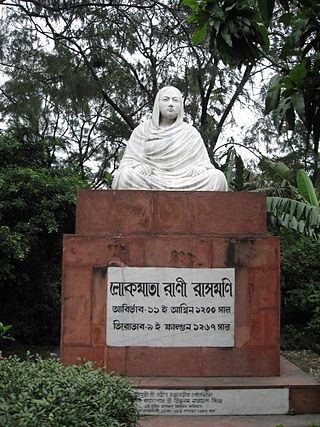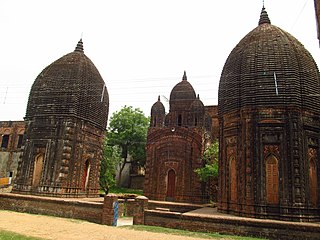
Dakshineswar Kali Temple or Dakshineswar Kalibari is a Hindu navaratna temple in Dakshineswar, Kolkata, West Bengal, India. Situated on the eastern bank of the Hooghly River, the presiding deity of the temple is Bhavatarini, a form of Parashakti Adya Kali, otherwise known as Adishakti Kalika. The temple was built in 1855 by Rani Rashmoni, a Zamindar, philanthropist and a devotee of Kali Maa. The temple is known for its association with Ramakrishna and Ma Sarada Devi, mystics of 19th century Bengal.

Rashmoni Das, popularly known as LokamataRani Rashmoni, also spelled as Rani Rasmani,, was an Indian businesswoman, entrepreneur, Zamindar, philanthropist and the founder of the Dakshineswar Kali Temple in Kolkata. She remained closely associated with Sri Ramakrishna Paramhansa after she appointed him as the priest of the Dakshineswar temple. She was also one of the earliest social reformers in early nineteenth-century Bengal and was one of the forerunners of the Bengal Renaissance. Besides, she also led many of the resistances against the encroaching British administration and their presence in all walks of colonial society in the Bengal province. Her other construction works include the construction of a road from Subarnarekha River to Puri for the pilgrims, Babughat, Ahiritola Ghat and Nimtala ghat for the everyday bathers at the Ganges. She also offered considerable charity to the Imperial Library, and the Hindu College.

The Rathayatra of Mahesh is the oldest chariot festival in Bengal, and is said to have been celebrated since 1396. The first temple of Jagannath Deb was built by Raja Manohar Roy Of Sheoraphuli Raj who also denoted large portion of land in establishing the Jagganathpur Mouza. It is held in Mahesh, a historical locality within Serampore in the Indian state of West Bengal. It is a week-long festival and a grand fair is held at that time. People throng to have a share in pulling the long ropes (Rosshi) attached to the chariots of Lord Jagannath, Balarama and Subhadra on the journey from the temple to Mahesh Gundicha Bari and back within 8th day.

Kharar is a historical town of Ghatal and one of the oldest town in Asia. This city is located in the Ghatal Subdivision of the Indian state of West Bengal.

Kotulpur is a community development block that forms an administrative division in the Bishnupur subdivision of the Bankura district in the Indian state of West Bengal.

The Puthia Temple Complex consists of a cluster of notable old Hindu temples in Puthia Upazila, Rajshahi District, Bangladesh. Located 23 km to the east of Rajshahi city, it has the largest number of historic temples in Bangladesh. The temples were built by Hindu Zamindars Rajas of the Puthia Raj family who were noted philanthropists of Rajshahi. The temples have been built in terracotta in a variety of styles combining the typical Jor-bangla architecture with other influences. The Rajbari or Palace of the Raja of Puthia and the Dol Mancha are part of the complex. The temples are laid out around a lake with a sprawling lawn.

Hinduism is the largest religious tradition in the Indian state of West Bengal with approximately 70.5% of the population identifying themselves as Hindus. The Hindus in West Bengal mostly belong to the Shakta, minority to Vaishnavite and a small community belong to Shaivite and other denominations. The vast majority of Hindus in West Bengal are Bengali Hindus numbering around 55 million and comprising 60.2% of the state population of 91.35 million (2011) but a notable section of non-Bengali Hindus also exist, particularly among Marwaris, Biharis, Odias, Gurkhas, Sindhis, Gujaratis and various tribal communities such as Koch, Santals, Munda and particularly Adivadis numbering around 9.4 million comprising rest 10.3% of the state population. Hindus have decreased in west bengal due to conversion to Islam which National Commission for Backward Classess(NCBC) notices.

Goghat II is a community development block that forms an administrative division in Arambag subdivision of Hooghly district in the Indian state of West Bengal.
Pilak is an archaeological site in the Santirbazar sub-division of South Tripura district of the Indian state of Tripura. Many images and structures, belonging to Buddhist and Hindu sects, have been discovered here since 1927. The antiquities found here are dated to 8th to 12th centuries.
Patrasayer is a village in the Patrasayer CD block in the Bishnupur subdivision of the Bankura district in the state of West Bengal, India.

Narajole is a village and gram panchayat in Daspur I CD Block in Ghatal subdivision of Paschim Medinipur district in the state of West Bengal, India.
Mankar is a village in Galsi I CD Block in Bardhaman Sadar North subdivision of Purba Bardhaman district in the state of West Bengal, India.

Sribati or Sreebati is a village and gram panchayat in Katwa II CD block in the Katwa subdivision of Purba Bardhaman district of West Bengal.
Hadal Narayanpur are two adjacent villages considered as one in the Patrasayer CD block in the Bishnupur subdivision of the Bankura district in the state of West Bengal, India.
Alangiri is a village in the Egra I CD block in the Egra subdivision of the Purba Medinipur district in the state of West Bengal, India.
The Parvatinatha Temple is a saptadasa-ratna (seventeen-pinnacled) temple, built in the 19th century at Chandrakona in Ghatal subdivision of Paschim Medinipur district in West Bengal, India.
Lachhipur is a village in the Ghatal CD block in the Ghatal subdivision of the Paschim Medinipur district in the state of West Bengal, India.

Bengal temple architecture is about temple styles developed and used in Bengal, particularly the chala, ratna and dalan temples.

Radh Bengal is a region in West Bengal also known as the Temple Town. This region consists of arrays of temples in varying sizes and devoted to different gods and goddess but the common thread unifying this group is that the temples are constructed in terracotta. The region consists of following districts Birbhum, Bankura, Burdwan, Purulia and parts of Murshidabad. The construction style originated in 16th century and lasted till the 19th century. This period is also referred as a golden age of temple in West Bengal. Reason for development of this construction technique was the rich red laterite soil of the region and lack of construction worthy stone. The skill of creating daily objects from like vessels, pottery, seal and toys evolved into a construction technique in the time of need. These temples are baked terracotta panels or bricks. This particular style spread outside the present day West Bengal as well, to Jharkhand, Bihar, Assam and Tripura.

Ramkeli Madanmohan Jiu Mondir is a Vaishnava temple at Ramkeli village in West Bengal. Hindu god Krishna is worshiped in the form of Madanamohan in this temple. It is located in the ruined medieval city of Gauda in Malda district. Built by Rupa Goswami and Sanatana Goswami, known as Mahavaishnavas, the temple stands in the northern part of the village. The present temple building is a great example of the combination of Dalan and Ratna architecture of the district; however, the temple was established in the first decade of the 16th century.


















